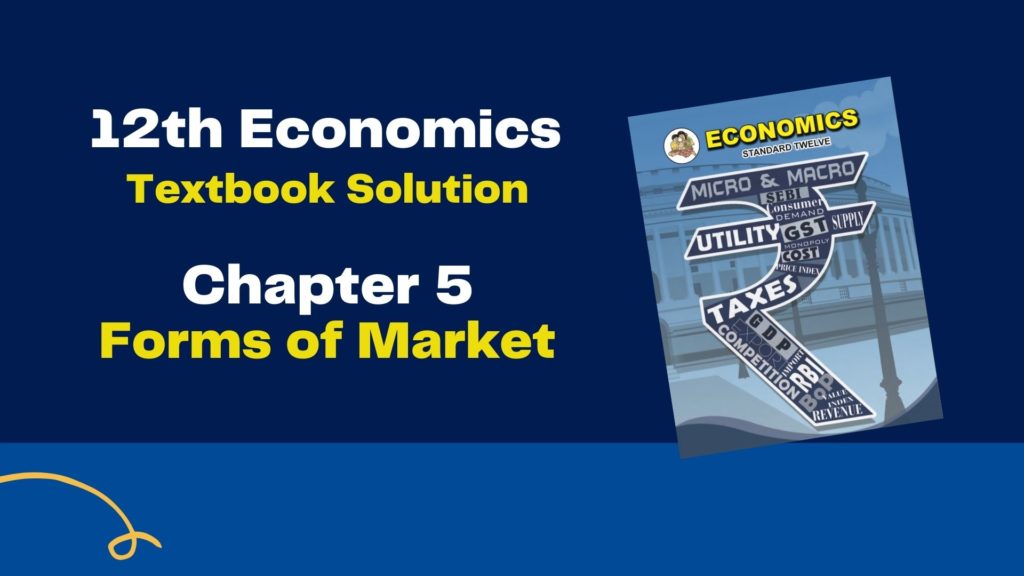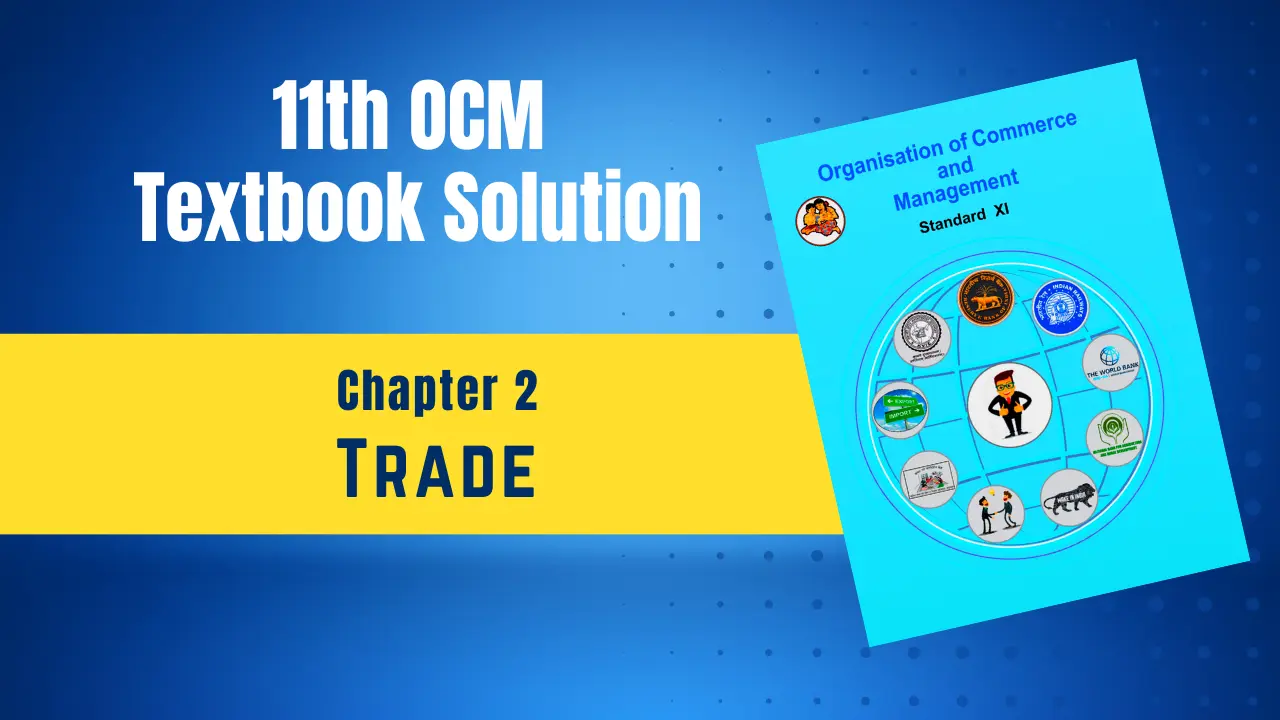12th Economics Chapter 5 Solutions (Forms of Market) Maharashtra Board – Free Solution
Table of Contents
12th Economics Chapter 5 Solutions

Chapter 5 – Forms of Market
Q. 1. Choose the correct option
1) In an economic sense, market includes following activities
a) The place where goods are sold and purchased.
b) An arrangement through which buyers and sellers come in close contact with each other directly or indirectly.
c) A shop where goods are sold.
d) All of the above.
Options:
1) a and b
2) b and c
3) a, b and c
4) only d
2) Classification of markets on the basis of place
a) Local market, National market, International market
b) Very short period market, Local market, National market.
c) Short period market, National market, International market.
d) Local market, National market, Short period market.
Options :
1) a, b and c
2) b, c and d
3) only a
4) a and d
3) Homogeneous product is a feature of this market.
a) Monopoly
b) Monopolistic competition
c) Perfect competition
d) Oligopoly
Options :
1) c and d
2) a, b and c
3) a, c and d
4) only c
4) Under Perfect competition, sellers are
a) Price makers
b) Price takers
c) Price discriminators
d) None of these
Options :
1) a, b and c
2) only b
3) only c
4) a and c
Q. 2. Give economic terms
1) The market where there are few sellers.
Answer: Oligopoly
2) The point where the demand and supply curve intersect.
Answer: Equilibrium point
3) The cost incurred by the firm to promote sales.
Answer: Selling cost
4) Number of firms producing identical products.
Answer: Industry
5) Charging different prices to different consumers for the same product or services.
Answer: Price Discrimination
Q. 3. Complete the Correlation
1) Perfect competition : Free entry and exit : : Monopoly : Barriers to entry.
2) Price taker : Perfect competition : : Price maker : Monopoly.
3) Single price : Perfect competition : : Discriminated prices : Monopoly
Q. 4. Find the odd word out
1) Selling cost: Free gifts, Advertisement hoardings, Window display, Patents.
2) Market structure on the basis of competition: Monopoly, Oligopoly, Very Short Period market, Perfect competition.
3) Features of monopoly: Price maker, Entry barriers, Many sellers, Lack of substitutes.
4) Legal monopoly: Patent, OPEC, Copyright, Trademark.
Solution of other subjects
Solution of all Chapters of Economics
1 – 2 – 3A – 3B – 4 – 5 – 6 – 7 – 8 – 9 – 10
Q.5. Answer the following
1) Explain the features of Oligopoly.
Answer: The term oligopoly is derived from the Greek words ‘Oligo’ which means few and ‘poly’ which means sellers. It is that market where there are a few firms (sellers) in the market producing either a homogeneous product or a differentiated product. For example, mobile service providers, cement companies etc.
Features of oligopoly:
1) Few firms or sellers:
Under oligopoly market, there are few firms or sellers. These few firms dominate the market and enjoy a considerable control over the price of a product.
2) Interdependence:
The seller has to be cautious with respect to any action taken by the competing firms. Since there are few sellers in the market, if any firm makes the change in the price, all other firms in the industry also try to follow the same to remain in the competition.
3) Advertising:
Advertising is a powerful instrument in the hands of oligopolist. A firm under oligopoly can start an aggressive
and attractive advertising campaign with the intention of capturing a large part of market.
4) Entry barriers:
The firm can easily exit from the industry whenever it wants. But has to face certain entry barriers such as Government licence, patents etc.
5) Lack of uniformity:
There is a lack of uniformity among the firms in terms of their size. Some firms may be small while others may be of bigger size.
6) Uncertainty:
There is a considerable element of uncertainty in this type of market due to different behaviour patterns. Rivals
may join hands and co-operate or may try to fight each other.
2) Explain the types of Monopoly.
.Answer: The term monopoly is derived from the Greek word ‘Mono’ which means single and ‘poly’ which means seller. Monopoly is a market in which there is only one seller who controls the entire market supply for a product which has no close substitute.
Following are the types of monopoly:
1) Private monopoly:
When an individual or private body controls a monopoly firm it is known as private monopoly. For example, Tata Group.
2) Public monopoly:
When the production is solely owned, controlled, and operated by the Government, it is known as a public monopoly. It is usually welfare-oriented. For example, Indian Railways.
3) Legal monopoly:
This monopoly emerges on account of legal provisions like patents, trade mark, copyrights, etc. The law forbids potential competitors to imitate the design or form of the product registered under given branded names. For example, Amul products.
4) Natural monopoly:
A monopoly created on the basis of natural conditions like climate, rainfall, specific location, etc. is known as a natural monopoly. For example, wheat from Punjab.
5) Simple monopoly:
In simple monopoly, seller or a firm charges a uniform price for its product to all the buyers.
6) Discriminating monopoly:
In discriminating monopoly, firm charges different prices to different buyers for the same product. For example, doctor charges different fees to different patients.
7) Voluntary monopoly:
To avoid cut throat competition, some monopolists voluntarily come together and form a group of monopolists. This facilitates them to maximize their profit. For example, the Organisation of Petroleum Exporting Countries (OPEC).
Q.6. Observe the table and answer the questions
1) Fill in the blanks in the above schedule.
| Price of banana (per dozon) in Rs. | Demand (in dozen) | Supply (in dozen) | Relation between DD and SS |
| 10 | 500 | 100 | DD > SS |
| 20 | 400 | 200 | DD > SS |
| 30 | 300 | 300 | DD = SS |
| 40 | 200 | 400 | DD < SS |
| 50 | 100 | 500 | DD < SS |
2) Derive the equilibrium price from the above schedule with the help of a suitable diagram.
Solution of other subjects
Solution of all Chapters of Economics
1 – 2 – 3A – 3B – 4 – 5 – 6 – 7 – 8 – 9 – 10
Q.7. Answer in detail
1) Explain the meaning of Monopolistic competition with its features.
Answer: Monopolistic competition is very realistic in nature. In this market, there are some features of perfect
competition and some features of monopoly acting together. Prof. E. H. Chamberlin coined this concept in his book “Theory of Monopolistic Competition” which was published in 1933.
Following are the main features of monopolistic competition:
1) Fairly large number of sellers:
In monopolistic competition, the number of sellers is large but comparatively, it is less than that of perfect competition. Due to this reason, sellers’ behaviour is like a monopoly.
2) Fairly large number of buyers:
In this market, there are a fairly large number of buyers. Consequently, no single buyer can influence the price of the product by changing his individual demand.
3) Product differentiation:
Product differentiation is the main feature of monopolistic competition. In this market, there are many firms producing a particular product, but the product of each firm is in some way differentiated from the product
of every other firm in the market. This is known as product differentiation. For example, mobile handsets, cold drinks etc.
4) Free entry and exit:
Under monopolistic competition there is freedom of entry and exit, that is new firms are free to enter the market if there is profit. Similarly, they can leave the market, if they find it difficult to survive.
5) Selling Cost:
Selling costs are peculiar to monopolistic competition only. It refers to the cost incurred by the firm to create more demand for its product and thus increase the volume of sales. It includes expenditure on advertisements, radio and television broadcasts, hoardings, exhibitions, window display, free gifts, free samples etc.
6) Close substitutes:
In monopolistic competition, goods have close substitutes to each other. For example, different brands of
soaps, toothpaste etc.
7) Concept of group:
Under monopolistic competition, Chamberlin introduced the concept of ‘Group’ in place of industry. Industry means the number of firms producing identical products. A ‘Group’ means a number of firms producing differentiated products that are closely related. For example, a group of firms producing medicines, automobiles etc.
2) Explain the meaning of Perfect competition with its features.
Answer: Perfect competition is an ideal and imaginary concept of market rather than an actual market. According to Mrs. Joan Robinson, “Perfect competition prevails when the demand for the output of each producer is perfectly elastic.”
Following are the features of Perfect Competition:
1) Large number of sellers and buyers:
Under perfect competition, there are large number of sellers and buyers. As mentioned earlier, each seller forms a negligible part in the total market. Hence, none of them is in a position to influence the price and
supply in the market. Thus, sellers are price takers under perfect competition. The number of buyers is also large. The share of each buyer is so negligible that none of them is in a position to influence the price in the market.
2) Homogeneous product:
An important feature of a perfectly competitive market is that the product sold is homogeneous or identical in respect of size, design, colour, taste etc. All the products are perfect substitutes to each other.
3) Free entry and exit:
There are no barriers to the entry and exit of firms. Any firm can enter or quit the industry at its own will. If
there is hope of profit, the firm will enter the market and if there is possibility of loss the firm will leave the market.
4) Single price:
A single uniform price prevails under perfect competition which is determined by the interaction of demand
and supply.
5) Perfect knowledge of market:
The buyers and sellers possess perfect knowledge about the market conditions. Every seller and buyer has knowledge about price, quality, source of supply of products etc.
6) Perfect mobility of factors of production:
There is perfect mobility of factors of production under perfect competition. Labour and capital are mobile not only geographically but also occupationally.
7) Absence of transport cost:
In perfect competition, price is uniform because we assume that transport cost does not exist. This assumption will lead to uniformity in price.
8) No government intervention:
Laissez-faire policy is an important feature of perfect competition. It means there is absence of Government intervention in economic activities.
Extra Questions
(i) Explain any four features of monopoly.
Answer: The term monopoly is derived from the Greek word ‘Mono’ which means single and ‘poly’ which means the seller. Monopoly is a market in which there is only one seller who controls the entire market supply for a product that has no close substitute.
The following are the main features of the monopoly market:
1) Single seller:
In a monopoly, there is no competition as there is only one single producer or seller of the product. But, the number of buyers is large.
2) No close substitute:
There are no close substitutes for the product of the monopolist. Therefore, the buyers have no choice. They have to either buy the product from the monopolist or go without it. The cross elasticity of demand for his product is either zero or negative.
3) Barriers to entry:
Entry of the rivals is restricted due to legal, natural, technological barriers which do not allow the competitors to enter the market.
4) Complete control over the market supply:
The monopolist has complete hold over the market. He is the sole producer or seller of the product.
5) Price maker:
A monopolist can fix the price of his own product as he controls the whole market supply. Monopolist is a price maker.
6) Price discrimination:
Monopolist being a price maker, he can charge different prices to different consumers for the same product, on the basis of time, place etc. Thus, price discrimination is an important feature of monopoly market. For example, students and senior citizens are provided railway tickets at concessional rates.
7) No distinction between firm and industry:
A monopolist is the sole seller and producer of the product. A monopoly firm itself is an industry.
Solution of all Chapters of Economics
| Chapter Name | Solution Link |
| 1) Introduction to Micro and Macro Economics | Click Here |
| 2) Utility Analysis | Click Here |
| 3A) Demand Analysis | Click Here |
| 3B) Elasticity of Demand | Click Here |
| 4) Supply Analysis | Click Here |
| 5) Forms of Market | Click Here |
| 6) Index Numbers | Click Here |
| 7) National Income | Click Here |
| 8) Public Finance in India | Click Here |
| 9) Money Market and Capital Market in India | Click Here |
| 10) Foreign Trade of India | Click Here |
Check out other posts related to the 12th Commerce
| Textbook Solutions of 12th Commerce (All Subjects) | Click Here |
| Free pdf of 12th Commerce Textbooks | Click Here |
| 12th Commerce IT MCQ Preparation (Online Test) | Click Here |
| 12th Commerce Paper Pattern and Chapter Wise Marks Distribution | Click Here |
| Sample Paper of 12th Commerce for Practice | Click Here |
| Solved Sample papers of 12th Commerce to improve Paper Presentation | Click Here |
| Old Question Papers of 12th Commerce with solution (All Subjects) | Click Here |


